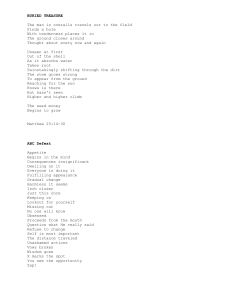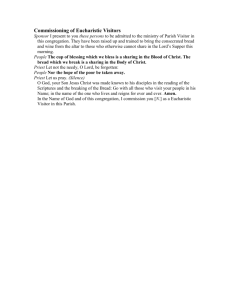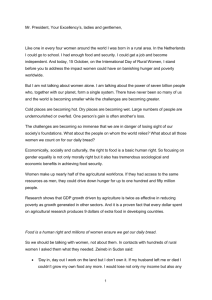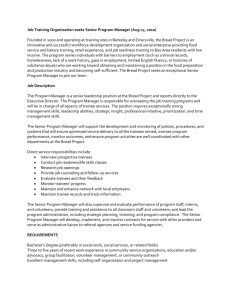WORD - ABC
advertisement
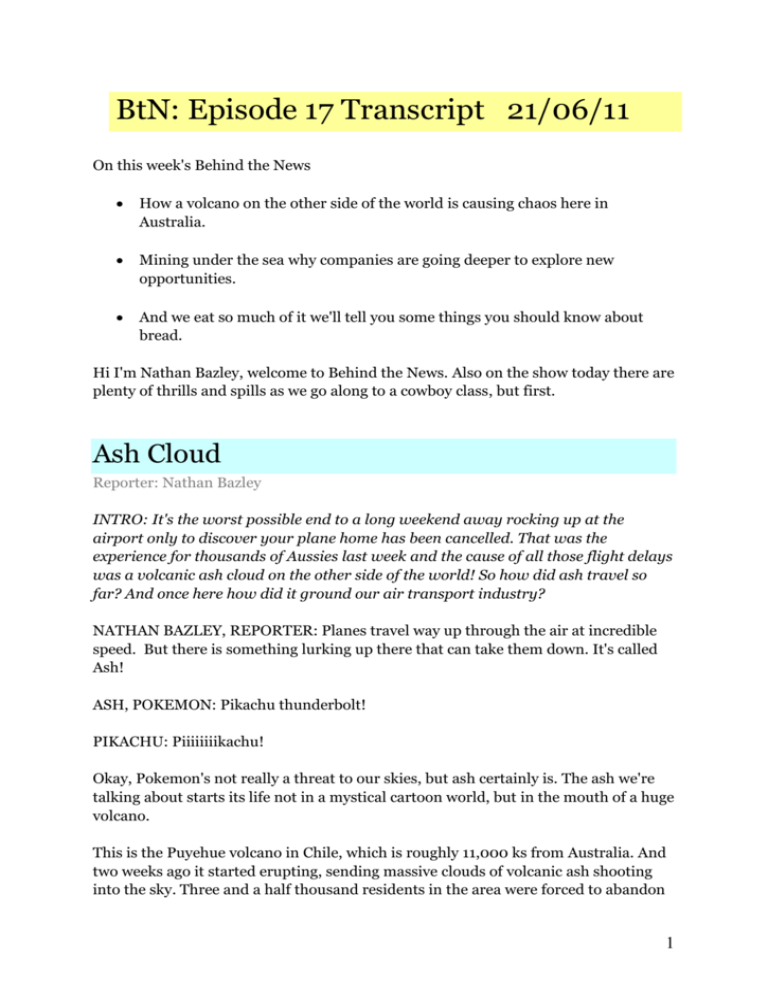
BtN: Episode 17 Transcript 21/06/11 On this week's Behind the News How a volcano on the other side of the world is causing chaos here in Australia. Mining under the sea why companies are going deeper to explore new opportunities. And we eat so much of it we'll tell you some things you should know about bread. Hi I'm Nathan Bazley, welcome to Behind the News. Also on the show today there are plenty of thrills and spills as we go along to a cowboy class, but first. Ash Cloud Reporter: Nathan Bazley INTRO: It's the worst possible end to a long weekend away rocking up at the airport only to discover your plane home has been cancelled. That was the experience for thousands of Aussies last week and the cause of all those flight delays was a volcanic ash cloud on the other side of the world! So how did ash travel so far? And once here how did it ground our air transport industry? NATHAN BAZLEY, REPORTER: Planes travel way up through the air at incredible speed. But there is something lurking up there that can take them down. It's called Ash! ASH, POKEMON: Pikachu thunderbolt! PIKACHU: Piiiiiiiikachu! Okay, Pokemon's not really a threat to our skies, but ash certainly is. The ash we're talking about starts its life not in a mystical cartoon world, but in the mouth of a huge volcano. This is the Puyehue volcano in Chile, which is roughly 11,000 ks from Australia. And two weeks ago it started erupting, sending massive clouds of volcanic ash shooting into the sky. Three and a half thousand residents in the area were forced to abandon 1 their homes and many are still in shelters. But as they waited for the danger to pass, the ash drifted higher and higher into the air. NATHAN: As you might know, hot air rises. So anything above a flame like this one, will slowly float up until the air cools again. But because a volcano is so hot, the ash from one can end up 15ks above the surface of the earth, where it meets some pretty intense winds. High up in the air around the top and bottom of the planet are jet winds that blow constantly at up to 400ks an hour, from west to east. And once the cloud of ash hits the winds, it's a one-way express trip right around the world. Its destination? The skies above Southern Australia and New Zealand. Alarm bells went off here, at the Darwin Volcanic Ash Advisory Centre. Their job is to monitor the skies above Australia to make sure there is no ash in the way of aircraft flight-paths. But why does it matter if a little ash is floating around? This recording captured the moment when all engines failed on a flight back in 1989, when a jumbo jet flew through an ash cloud. Luckily the crew managed to fly out of the cloud and restart the engines. NATHAN: The problem is that volcanic ash is made up of a substance similar to sand, and when heated to a very high temp, like it would be in the jet engines of a plane, it turns to something like glass. And that can stuff up an engine pretty quickly. Other problems can come from the ash blocking vital instruments and scratching the windscreen, wings and lights of the plane. So that's why flights were cancelled in Australia when word of the ash cloud spread. But why did some airlines fly, while others stayed on the ground? Well it all comes down to their idea of what's safe. Some thought it would be ok to fly around the ash clouds, or to fly underneath them. They were happy to do it, even though it would mean using more fuel, which would cost the airline more money. But some airlines thought that even those ideas were too much of a risk and preferred to leave their planes on the ground. In the end, the only way this airline chaos can come to an end, is for the Chilean volcano to stop pushing out huge clouds of ash. And it's looking like that's starting to happen. Maybe Pikachu had something to do with it after all. Presenter: Let's take a look at some more of the week's big news stories now. Here's Matt with the Wire. 2 The Wire The Opposition is stepping up its fight against the Government's planned Carbon Tax by demanding Australians vote on it. They have introduced a bill into parliament trying to force the government to hold a vote on the subject at a cost of 80 million dollars. That's called a ‘plebiscite’ but even if a majority of Australian's voted against the Tax the result wouldn't be binding meaning the government could still stick with their plan regardless. And if the Opposition got into power they've said they'd get rid of a Carbon Tax whether people voted for it or not. **** And in China more than 100 people have died in floods caused by torrential rain. It's estimated more than 5 million people have been affected - many of them are now homeless. This couple was left stranded hundreds of metres from dry land. They were crossing a bridge when it got swamped by the flood. They were rescued, after waiting almost an hour. The floods in eastern china are the worst in decades. Underwater Mining Reporter: Kirsty Bennett INTRO: As we heard earlier in the show volcanoes on land can cause a bit of trouble! But what about volcanoes in the ocean? We don't see the explosions and the smoke but these deep sea volcanoes are attracting a lot of attention. They're rich in metals like copper, silver and zinc so one mining company is pretty keen to get a hold of them. But what else could they be digging up? Kirsty takes a look. KIRSTY BENNETT, REPORTER: Mining companies search far and wide for the next big pocket of resources. It might not look like it to us, but they've only just scraped the surface. Deep in the ocean could be mining's next riches. And with most of the Earth covered in water, it's an exciting prospect. But before you dive down with a pick and shovel, we'd better tell you that it's not that easy. Soon we'll get into why but first let's look at the creation that's got the mining industry's attention. These are underwater volcanoes called hydrothermal vents. They form hundreds or sometimes thousands of metres deep in the ocean. They're made when the plates in the earth's crust move apart. Seawater is pulled in to the cracks and is heated up. On the way out, it picks up chemicals before gushing up through the sea floor. What was seawater is now a special hot fluid. When it meets the cold sea water, it changes again 3 and eventually settles to form these chimneys. And in the chimneys are minerals like copper, zinc, lead, silver and gold. And this is getting mining companies really excited. One company is planning to mine hydrothermal vents off the coast of Papua New Guinea. If it goes ahead it'll be the world's first open cut mine for copper and gold on the sea floor. So how will they do it? These vacuum cleaner looking machines will crush the chimneys and anything that's left living on them. Many interesting species have thrived around these strange underwater volcanoes. Like snails, mussels, crabs, certain bacteria and other things. PROFESSOR CINDY LEE VAN DOVER, BIOLOGIST: I could take you tomorrow to a place where we'd find a new hydrothermal vent that would almost certainly have dozens, if not hundreds of new species. KIRSTY: Biologists are worried that if mining scrapes away all this life it could change the environment and the kind of creatures that live here. But it's not as simple as saying underwater mining is bad for the environment. Many think it's actually better than mining on land. Think of all the work and machinery needed to make the massive holes on dry land. And sometimes these holes can produce acid when the deep earth mixes with rainwater. But it's a different way of doing things in the ocean. DR CHRIS YEATS, GEOLOGIST: Something like ploughing a field or raking your garden, that you're, you're, you're stirring up the environment but you're not fundamentally changing it. KIRSTY: And it can be an efficient way of mining. To get the same amount of minerals on dry land. you'd need to mine an area 10 to 15 times bigger. So while Presenter: OK let's make that the subject of our poll this week. Online Poll The question is: Is underwater mining a good idea? To vote just head to our website. And let's take a quick look at the results of last week's poll. We asked if you thought manners were less important today. 43 per cent said 'Yes' manners are less important. And 57 per cent thought manners are just as important now as they used to be. Thanks for taking part. 4 Daily Bread Reporter: Natasha Thiele INTRO: We eat it for breakfast lunch and sometimes even dinner. Australian’s munch through a lot of bread. And there are so many different types to choose from. So what's the difference? Tash went to a bread factory to find out. Take a look inside most Aussie lunch boxes and you'll find a familiar friend. But what is it? Bread! And it's a big part of our everyday lives, because it's easy to prepare and you can eat it with anything. Australians have been making and enjoying bread for many decades. In fact, an average family goes through about two loaves of bread a week, that's more than 100 loaves a year! And it's been around for a long time. Egyptians have been eating bread for thousands of years. Since then it's been vital to human survival because these flurry slices contain some of the vital energy and nutrients our body needs for the day. And that energy starts its life, here. It's a crop which we grow in Australia called 'wheat'. It's packed with carbohydrates, which our body burns to provide us with energy. Wheat grains are crushed and turned into white or wholemeal flour, which can then be used to make bread. Making bread can be as simple as mixing together flour, water, salt, sugar and something called 'yeast'. Yeast is a living organism which helps bread rise when it's cooked. And this is what happens when you add it to warm water and sugar. Within minutes, you can see it start to bubble. That's the yeast growing and as it does it releases bubbles of carbon dioxide. That simple bread recipe is basically the same one used at small bakeries or much larger commercial bread factories like this one. Both places make bread just like you would at home, but on a massive scale. They use big industrial mixers to combine the ingredients. Once the loaves are cooked, they go along conveyor belts where they're sliced and packed. Then it's onto the crates, ready for the supermarket shelves. That's where you'll find lots of different types of bread like white, multi-grain and wholemeal. But with Australians eating so much bread, making sure we're eating the healthiest type is important. And there's a lot of advice floating around about which type we should be aiming for. One of the products you might have heard people recommend is whole-grain bread. Grains like wheat have three main parts in each tiny kernel. The white flour used to make most bread only comes from the middle bit called the 'endosperm'. But the other two parts of the grain, the bran and the germ, contain lots of the nutrients like fibre, iron and protein. So that's why many nutritionists recommend whole grain breads, because they give you the goodness from the whole grain. Some people also recommend eating flat breads and wraps, rather than slices of bread. The reason for this is some flat breads can contain less bread per serving, so 5 they have less energy in them and are therefore less likely to make you put on weight, if you're not active. It can also mean that you can fill-up on more of the nutritious fillings inside. But if your wrap is filled with something unhealthy, it's going to defeat the purpose! Of course the best way to know exactly how healthy your bread is, is to try making it from scratch at home! Presenter: I'm sure you're hungry now so let's try to distract you with a quiz Quiz 1 The question is: What's the name for bread made without yeast? Is it a: Cracker Unleavened bread or Wholemeal bread Answer: Unleavened And it's also sometimes called flat bread but some flatbreads do have yeast. Confusing hey? Cowboy School Reporter: Natasha Thiele INTRO: Now most of us know what to expect from the average day at school. Well, kids in some country places get into a few extra lessons that you might like to have a go at. They learn the ropes of being a cowboy or cowgirl and it's making a big difference to their lives. Tash checked it out. NATASHA THIELE, REPORTER: When you picture cowboys, you might think they look like this! But these days, it's not about the tough looks and attitude. Instead, it's all about hanging on! Welcome to cowboy class! It's not your average classroom, so you won't find any books, pens and tables here. But what you will find are lots of enthusiastic kids in cowboy hats. Kids are taught how to become modern-day rodeo riders. 6 MARCELLO SMITH, RODEO CLUB CO-ORDINATOR: These boys learn teamwork, helping their mates, putting on a good show for public, representing their school, representing themselves. And while it's all boys at this class, girls do get involved too. And for those who want to take rodeo to the next level, they can swap the horse for a raging bull! This is professional rodeo! Some people reckon rodeos are cruel to the animals, but the people that do it say the animals are well looked after. The riders need to follow certain rules like staying on for 8 seconds and keeping your hand up in the air all the time and judges give you and the bull a score out of 25, depending on how wild the animal is and how well you ride. The sport's a big deal especially in the US where they have glitzy TV shows dedicated to rodeos like this one called "Professional Bull Riders". REPORTER: But before you get there, most people have to start out on one of these. It's a mechanical bull and it's a good way to learn the basics. You can quickly learn how tough it is without getting hurt. But there's no padded landing area in real rodeo, so back at the school the students have to wear protective gear. BILL, STUDENT: Just come back off my rope and just fell back on him and he flicked me forward in the air, just yeah did a bit of somersault. But even then, it can still be really dangerous. Blake came to this school last year and broke his ankle. He's back again, but his bad luck has followed him. This time he's broken his collar bone! LISA SMITH, RODEO CLUB FOUNDER: Some people should probably not ride or stick to bicycles. But the school says safety always comes first for the kids and for the animals too. But even though the kids might pick up a few bumps and bruises, it's hoped they'll also pick up some valuable skills along the way. Quiz 2 Now our next quiz is going to be a cowboy spelling test! The question is: Can you spell the loop of rope which is used by cowboys? A. Lasso 7 B. Lassoo C. Lasoo Answer: A. Lasso Tricky word to get right that one. Okay, time to get into some more sporting action here's The Score. The Score To the V8's first and this is what happens when your car spills oil all over the road. You spin out really quickly! Jason Bright was the casualty of that mechanical fault at Darwin's Hidden Valley track on Sunday but other cars struggled to stay on the road even without oil under their tyres. By the end of the race the field had whittled down to a tight battle between Craig Lowndes and young racer Shane Van Gisbergen. And despite his lack of experience Shane managed to pass Lowndes to take the win. It's only the second of his career. ***** And changing pace this week is refugee week a time when focus turns to the issues affecting people who have fled their home countries in search of a new life. And one of those issues is sport because playing club sports in Australia like soccer can be expensive. COACH: Membership fees are one of the issues why young people don't get involved in soccer clubs. That was holding these guys back from forming a team but today they're training for a purpose. A grant and some assistance from their local council has helped get them into a league and they couldn't be more excited. And in their first match this weekend that's exactly what they did beating their much more experienced competitors 5 - nil. Twice the Talent Reporter: Kirsty Bennett 8 INTRO: Next week Australia's women's soccer team will battle it out in Germany for the World Cup. But one sport star in this elite squad is already a world champion. Her name's Ellyse Perry and she'll be the first Aussie to play in the World Cup in two different sports. Kirsty explains. KIRSTY BENNETT, REPORTER: Most sport stars are only at the top in one game. But who says you can't be great in more sports than that? Well there's one rising star who's proving you can get to the top in two. Ellyse Perry is breaking records and stereotypes. She's played cricket against men was the youngest ever cricketer to play for Australia, has helped win a cricket world cup and has been asked to represent her country again, this time in soccer. ELLYSE PERRY: I don't see it as being anything special compared to the achievements of some of our most fantastic athletes. KIRSTY: So if it's not such a big deal, then why don't we see more athletes at the top in two sports at the same time? One of the main reasons is at the top level of sport you need to put in a lot of time and hard work. AFL and rugby players train for about 11 months of the year so there's not much time to do another sport. Also top athletes work on getting their bodies into a particular shape, strength and weight to give them the best chance of succeeding in their sport. So in the end sport professionals will nearly always choose just one sport to focus on. Everyone knows Shane Warne as one of the world's best spin bowlers. But you probably didn't know that he was once a promising footy star and even turned out for St. Kilda's reserves team! And you've probably seen Lleyton Hewitt's passion on the tennis court. But before this racquet took up all his time he too was a promising young footy player. So while Shane and Lleyton gave up a sport when they were young there are some players who try to do the switch when they're much older. Israel Falou is a huge name in rugby league but was lured over to the AFL with a multi-million dollar pay packet. He hasn't played a top-flight game yet but will have his work cut out if he's going to transfer his skills to a different sport. As for Ellyse it's her coaches and work ethic that have allowed her to juggle both cricket and soccer. In fact her coaches reckon playing two sports actually helps her deal with things like pressure in competitions. The advice from sport experts is to play as many sports as you can while you're growing up so you develop lots of different skills. Like hand-eye coordination, footwork, agility, strength and fitness. ELLYSE PERRY: Yeah, don't be afraid to have a go at anything, and especially I guess, speaking from a girl's perspective, just because the boys are playing doesn't 9 mean you can't play. Not only the physical, but the mental and the social benefits that I've received from sport I think can be offered to anyone, and particularly young girls, and, yeah, it's a really fantastic thing. So I'd love to see more girls being involved in sport and enjoying it. KIRSTY: So with twice the talent, it looks like Ellyse in on track to have double the success! Presenter: Talented girl and that's it for the show. Closer You can jump onto our website if you want to get more info on any of the stories. You can send us your comments and don't forget to vote in this week's poll. And I'll see you next time. 10


